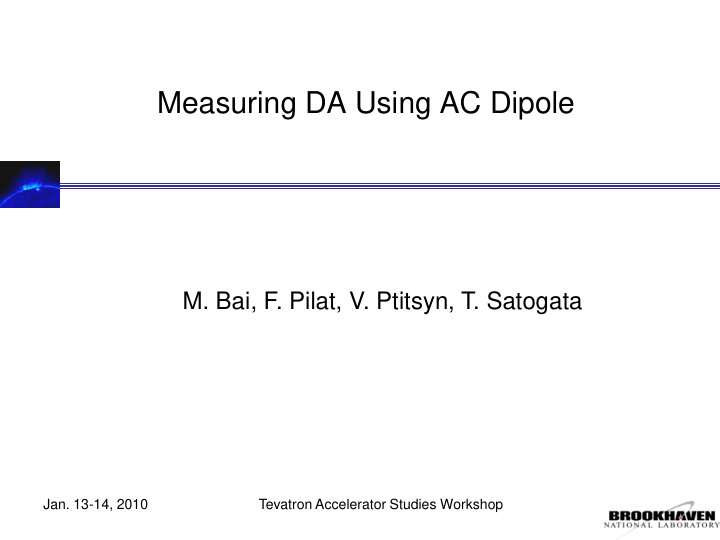



Measuring DA Using AC Dipole M. Bai, F. Pilat, V. Ptitsyn, T. Satogata Jan. 13-14, 2010 Tevatron Accelerator Studies Workshop
Outline • Introduction and motivation • Experiment description • Summary
Introduction • Traditionally, DA is measured by using pulsed kicker to blowup beam emittance till it hits DA limit ramp 6 bunches (avoid possible emittance blow-up) use scrapers to confirm halo beam size (PIN diodes) and core beam size (DCCT and WCM, beam intensity) increase H emittance of bunches selectively via tune meter kicks (1 Hz) measure continuously emittance with IPM (and Schottky) emittance ‘saturation’ defines aperture use scrapers to confirm beam size check loss pattern and use orbit to discriminate physical from dynamic aperture (physical typically at the abort, and triplets) repeat procedure for vertical emittance
RHIC DA Measurement in RUN04 Fulvia, Nikolay, Steve T, Vadim • Gradually increase beam IPM measurements size with tune-meter kicker to reach dynamic aperture limits • Signature: – IPM emittance saturation – reaching limit of transverse distribution width – beam losses • Beam loss location was at 6 and/or 8 o’clock triplets • Best measured aperture (good working point, no beam-beam, IR correctors On) is about 11 s (for 10 p initial emittance) Courtesy of Fulvia
Motivation • Traditional technique of DA measurement worked well but can be slow due to limited strength of tune meter kicker at store • Alternative technique to increase the beam emittance more efficiently – Quick DA measurement – Verify DA for different configurations of machine, i.e. different optics(working point, beta*), non-linear corrections, w/w.o. beam-beam, etc.
Motivation • The two RHIC ac dipoles are designed to achieve a 8 s driven oscillation at store if the driving tune is 0.005 away from the betatron tune.
Motivation • The two RHIC ac dipoles are designed to achieve a 8 s driven oscillation at store if the driving tune is 0.005 away from the betatron tune. • Beam is continuously driven by an ac dipole until it hits the limit, i.e. non-zero beam losses. Then shuts the ac dipole off abruptly to allow beam emittance blowup. Measure beam emittance and loss rate. – Pros: • Fast, and allows one to measure linear and non-linear beam dynamics as function of amplitude – Cons: • The maximum amplitude of the driven oscillation is not a direct measure of DA • Have to differentiate the physical aperture limit from dynamic aperture limit
Beam Dynamics using AC Dipole • Linear optics • Non-linear resonance driving term as function of betatron amplitude • Local coupling Driven oscillation amp. • million turn beam position data DA • Derive non-linear resonance BmL driving term, local coupling for every 1k turns of data time
Non-linear resonance driving term using ac dipole First 3 rd order resonance driving term measurement in RHIC with ac dipole Rogelio, Wolfram Rama, Mei, … Ç√ Ç√ Ç√
Local Coupling Measurement using ac dipole Rogelio, Wolfram Rama, Mei, … First 3 rd order resonance driving term measurement in RHIC with ac dipole Rogelio, Wolfram Rama, Mei, …
Experience of DA measurement at RHIC - Tested with proton beam during RHIC run 2009 - significant beam losses associated with ac dipole excitation. drove beam at more than 0.02 away from betatron tune. Trade off is the size of the excitation is limited, ~ 1mm
Experience of AC Dipole DA measurement at RHIC Possible causes - non-linearity? detailed data analysis of the million turn by turn bpm data - harmonics in the ac dipole current? 30 dB down as measured simulations - chromaticity too large? normally done empirically observe the tune spread by tune measurement simulations
DA Measurement Using AC Dipole at Tevatron • What Tevatron has – One vertical ac dipole: 4\sigma – Excellent bpm system: 31k turn by turn – Beam profile monitor – Beam loss monitor – Beam current monitor
Experiment Description • Goal: – proof the principle of using ac dipole to measure DA – calibrate this method against the traditional method 3 production dynamic aperture measurements – Explore non-linear resonance driving terms as a function of driven oscillation amplitude
Experiment Description • Dynamic aperture measurement – At injection: ~ 3 hours • Drive the beam with an ac dipole. The oscillating amplitude of the ac dipole field strength is slowly ramped up. The turn by turn beam position data is recorded. Abruptly shut off the ac dipole as soon as the beam losses were seen. Measure the beam emittance and loss rate • Measure DA with the traditional technique using tune meter kicker. Compare the two results – At store: ~ 3hours • Repeat the above experiment
Recommend
More recommend